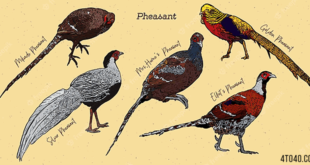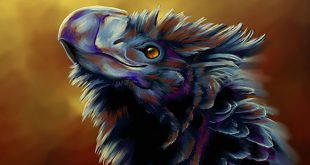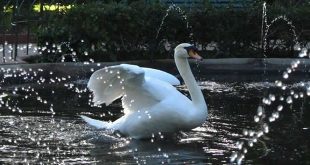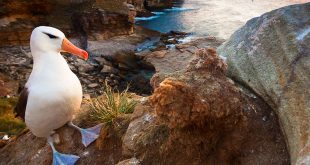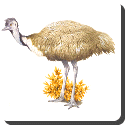 Emu — The Emu (Dromaius novaehollandiae) is the largest bird native to Australia and the only extant member of the genus Dromaius. It is the second-largest extant bird in the world by height, after its ratite relative, the ostrich. There are three subspecies of Emus in Australia. The Emu is common over most of mainland Australia, although it avoids heavily populated areas, dense forest, and arid areas.
Emu — The Emu (Dromaius novaehollandiae) is the largest bird native to Australia and the only extant member of the genus Dromaius. It is the second-largest extant bird in the world by height, after its ratite relative, the ostrich. There are three subspecies of Emus in Australia. The Emu is common over most of mainland Australia, although it avoids heavily populated areas, dense forest, and arid areas.
The soft-feathered, brown, flightless birds reach up to 2 metres (6.6 ft) in height. They have long thin necks and legs. Emus can travel great distances at a fast, economical trot and, if necessary, can sprint at 50 km/h (31 mph) for some distance at a time. Their long legs allow them to take strides of up to 275 centimetres (9.02 ft) They are opportunistically nomadic and may travel long distances to find food; they feed on a variety of plants and insects, but have been known to go weeks without food. Emus ingest stones, glass shards and bits of metal to grind food in the digestive system. They drink infrequently, but take in copious fluids when the opportunity arises. Emus will sit in water and are also able to swim. They are curious birds who are known to follow and watch other animals and humans. Emus do not sleep continuously at night but in several short stints sitting down.
Emus use their strongly clawed feet as a defence mechanism. Their legs are among the strongest of any animals, allowing them to rip metal wire fences. They are endowed with good eyesight and hearing, which allows them to detect predators in the vicinity. The plumage varies regionally, matching the surrounding environment and improving its camouflage. The feather structure prevents heat from flowing into the skin, permitting Emus to be active during the midday heat. They can tolerate a wide range of temperatures and thermoregulate effectively. Males and females are hard to distinguish visually, but can be differentiated by the types of loud sounds they emit by manipulating an inflatable neck sac. Emus breed in May and June and are not monogamous; fighting among females for a mate is common. Females can mate several times and lay several batches of eggs in one season. The animals put on weight before the breeding season, and the male does most of the incubation, losing significant weight during this time as he does not eat. The eggs hatch after around eight weeks, and the young are nurtured by their fathers. They reach full size after around six months, but can remain with their family until the next breeding season half a year later. Emus can live between 10 and 20 years in the wild and are predated by dingos, eagles and hawks. They can jump and kick to avoid dingos, but against eagles and hawks, they can only run and swerve.
The Tasmanian Emu and King Island Emu subspecies that previously inhabited Tasmania and King Island became extinct after the European settlement of Australia in 1788; and the distribution of the mainland subspecies has been influenced by human activities. Once common on the east coast, Emu are now uncommon; by contrast, the development of agriculture and the provision of water for stock in the interior of the continent have increased the range of the Emu in arid regions, and it is of Least Concern for conservation. They were a food and fuel source for indigenous Australians and early European settlers. Emus are farmed for their meat, oil, and leather. Emu is a lean meat and while it is often claimed by marketers that the oil has anti-inflammatory and anti-oxidative effects, this has not been scientifically verified in humans. The Emu is an important cultural icon of Australia. It appears on the coat of arms, various coins, features prominently in Indigenous Australian mythology, and hundreds of places are named after the bird.
Although the Emu was long classified with its closest relatives, the cassowaries, in the family Casuariidae, part of the ratite order Struthioniformes, an alternate classification has been recently adopted which splits the Casuariidae into their own order, Casuariformes. Two different Dromaius species were common in Australia before European settlement, and one additional species is known from fossil remains. The small emus—D. baudinianus and D. n. ater—both became extinct shortly after the arrival of Europeans. D. novaehollandiae diemenensis, a subspecies known as the Tasmanian Emu, became extinct around 1865. However, the mainland sub-species of D. novaehollandiae, remain common. Their population size vary from decade to decade, largely dependent on rainfall; current estimates range from 625,000 to 725,000 birds, with 100,000–200,000 in Western Australia and the remainder mostly in New South Wales and Queensland. Emus were introduced to Maria Island off Tasmania and Kangaroo Island near South Australia during the 20th century. While the Maria Island population became extinct in the mid 1990s, the Kangaroo Island birds have established a breeding population.
Emus are large birds. The largest can reach up to 150 to 190 centimetres (59–75 in) in height, 1 to 1.3 metres (3.3–4.3 ft) at the shoulder. Emus weigh between 18 and 55 kilograms (40 and 121 lb). Females are usually larger than males by a small amount, but substantially wider across the rump.
Emus live in most habitats across Australia, although they are most common in areas of sclerophyll forest and savanna woodland, and least common in populated and very arid areas, except during wet periods. Emus predominately travel in pairs, and while they can form enormous flocks, this is an atypical social behaviour that arises from the common need to move towards food sources. Emus have been shown to travel long distances to reach abundant feeding areas. In Western Australia, Emu movements follow a distinct seasonal pattern—north in summer and south in winter. On the east coast their wanderings do not appear to follow a pattern. Emus are also able to swim when necessary, although they rarely do so unless the area is flooded or they need to cross a river.
 Kids Portal For Parents India Kids Network
Kids Portal For Parents India Kids Network
